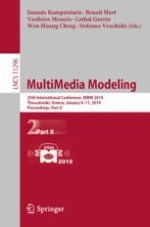2019 | Buch
MultiMedia Modeling
25th International Conference, MMM 2019, Thessaloniki, Greece, January 8–11, 2019, Proceedings, Part II
herausgegeben von: Ioannis Kompatsiaris, Dr. Benoit Huet, Vasileios Mezaris, Cathal Gurrin, Wen-Huang Cheng, Dr. Stefanos Vrochidis
Verlag: Springer International Publishing
Buchreihe : Lecture Notes in Computer Science
